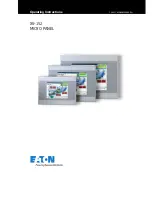
© 2010 Utilicor Technologies Inc.
38
MSDS page 2
====================================================================
SECTION V - REACTIVITY DATA
====================================================================
Stability:
Stable under the recommended storage and handling conditions prescribed. Product
becomes alkaline on contact with moisture. Hazardous polymerization will not occur.
Incompatible materials:
Water, oxidizing agents, acids.
Conditions of reactivity:
Keep away from moisture until product is used. Stable under
ambient pressure and temperature.
Hazardous decomposition products:
None known. Refer to Section IV for ‘Hazardous
combustion products’.
====================================================================
SECTION VI - TOXICOLOGICAL PROPERTIES
====================================================================
***Routes of exposure and acute effects***
Exposure limit:
ACGIH-TLV: Silica, crystalline – 0.05 mg/m
3
; Portland cement – 10 mg/m
3
;
Carbon black – 3.5 mg/m
3
.
OSHA-PEL: Silica, crystalline – 10 mg/m
3
(respirable)
; Portland cement – 15 mg/m
3
(total
dust)
; Carbon black – 3.5 mg/m
3
.
Inhalation:
Harmful if inhaled. Inhalation of dusts causes irritation to the nose, throat and
respiratory tract. Symptoms may include coughing and inflammation of nasal tissues.
Skin:
Short term exposure to dry dusts may cause mild irritation. Longer exposures or contact
with wet product could cause severe irritation and/or chemical burns. Burns may be delayed.
Eyes:
Direct eye contact may cause mild to severe irritation. Could cause chemical burns and
eye damage if not promptly removed.
======================================================================
SECTION VI - TOXICOLOGICAL PROPERTIES CONTINUED
====================================================================
Ingestion:
May be harmful if swallowed. May cause irritation to mouth, throat and stomach.
Chronic effects:
Prolonged or repeated inhalation may cause severe, irreversible scarring of
lung tissue (silicosis). Prolonged or repeated skin contact may cause severe dermatitis (drying
and cracking).
Carcinogenicity:
Contains Crystalline silica. Crystalline silica is classified as carcinogenic to
humans by IARC (Group 1) and ACGIH (Group A2). Contains Carbon black. Carbon black is
classified as possibly carcinogenic to humans by IARC (Group 2B).
Reproductive effects, Teratogenicity, Mutagenicity:
Contains Carbon black. Carbon black
may cause mutagenic effects to non-reproductive cells, based on animal evidence.
Sensitization to material:
None known.
Synergistic materials:
N/Av.
Conditions aggravated by exposure:
Pre-existing skin, eye and respiratory disorders.






































